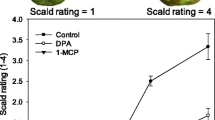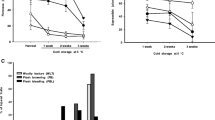Abstract
Stored fresh-cut endive gradually turns red, since tissue wounding induces de novo synthesis of phenylalanine ammonia-lyase (PAL), which activates the phenylpropanoid pathway. Once the pool of phenolic substrates is increased, polyphenols are oxidized and cause discoloration. Modified atmosphere packaging (MAP) and controlled atmosphere storage (CA) have been used to control browning. This paper describes the combined effects of heat shock (46 °C/120 s) and CA on the quality of cut endive stored at 10 °C. Heat shock protein (HSP90) and PAL expression patterns were analysed in endive sliced tissues. Real-time quantitative PCR (qPCR) was performed for PAL1 and PAL2 as well as for degenerated HSP90 primers. PAL1 and PAL2 were strongly expressed in unheated cut tissues, in which maximum accumulation of PAL1 mRNA occurred 12 h after cutting. Heat shock significantly reduced the level of PAL1 transcripts in sliced endive, which was related to the prevention of discoloration. Controlled atmosphere storage had an effect on PAL1 but not on PAL2 transcription. Peak levels of HSP90 transcript accumulation were found after 6 h, with an increasing and apparently cumulative effect of wounding and CA. Image analysis of the slices after 48 h clearly showed that heat-treated samples were similar to the control, with no significant difference between air and CA storage. These results show that there could be inhibition of PAL1 isoform expression in endive slices after heating.




Similar content being viewed by others
References
Vanstreels E, Lammertyn J, Verlinden BE, Gillis N, Schenk A, Nicolaï BM (2002) Postharvest Biol Technol 26:313–322
Bruxelles GL, Roberts MR (2001) Crit Rev Plant Sci 20:487–521
Tomas-Barberan FA, Loaiza-Velarde JG, Bonfanti A, Saltveit ME (1997) J Am Soc Hortic Sci 122:399–404
Peiser G, Lopez Galvez G, Cantwell M, Saltveit ME (1998) J Am Soc Hortic Sci 14:171–177
Martin-Diana AB, Rico D, Frias J, Henehan GTM, Mulcahy J, Barat JM, Barry-Ryan C (2005) J Food Eng 77(4):1069–1077
Satveit ME (2001) J Am Soc Hortic Sci 21:169–177
Murata M, Tanaka E, Minoura E, Homma S (2005) Biosci Biotechnol Biochem 68:501–507
Belanger FC, Brodi MR, Ho T-HD (1986) Proc Acad Sci USA 83:1354–1358
Lanciloti DF, Cwik C, Brodi MR (1996) Physiol Plant 97:513–523
Kang H, Saltveit ME (2003) Physiol Plant 119:450–455
Loaiza-Velarde JG, Saltveit ME (2001) J Am Soc Hortic Sci 26:227–234
Campos-Vargas R, Hiroyuki N, Trevor S, Saltveit ME (2005) Physiol Plant 123:82–91
Rocculi P, Romani S, Dalla-Rosa M (2004) Food Res Intern 34:329–335
Chomczynski P, Sacchi N (1987) Anal Biochem 162:156–159
Livak KJ, Schmittgen TD (2001) Methods 25:402–408
Walker JRL (1995) In: Lee CY, Whitaker JR (eds) ASC symposium series 600. American Chemical Society Washington DC, pp 8–22
Ke D, Saltveit ME (1989) Physiol Plant 76:412–418
Acknowledgments
The authors are grateful to Patrick Varoquaux and Françoise Varoquaux for their precious support during the experiments.
Author information
Authors and Affiliations
Corresponding author
Rights and permissions
About this article
Cite this article
Salman, A., Goupil, P., Filgueiras, H. et al. Controlled atmosphere and heat shock affect PAL1 and HSP90 mRNA accumulation in fresh-cut endive (Cichorium intybus L.). Eur Food Res Technol 227, 721–726 (2008). https://doi.org/10.1007/s00217-007-0778-6
Received:
Revised:
Accepted:
Published:
Issue Date:
DOI: https://doi.org/10.1007/s00217-007-0778-6




